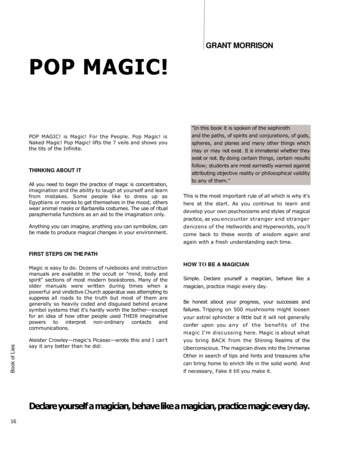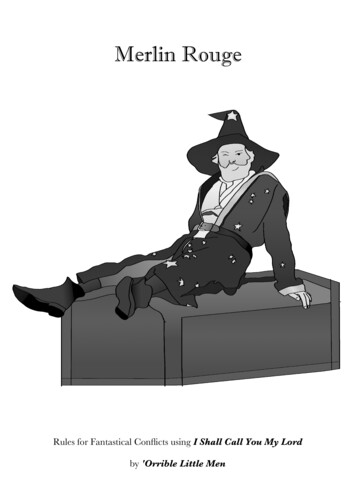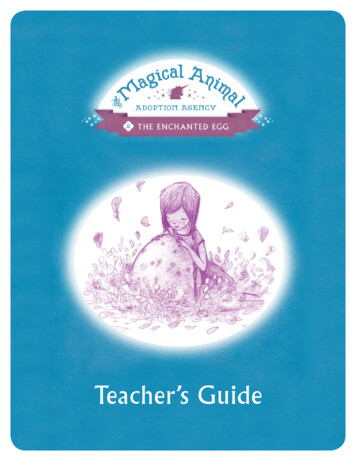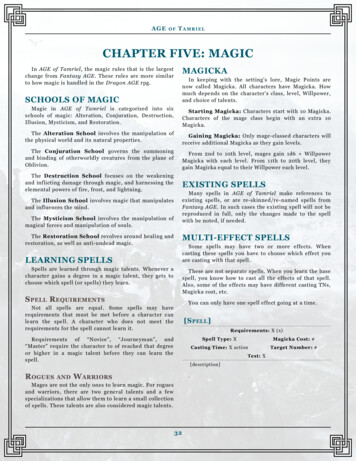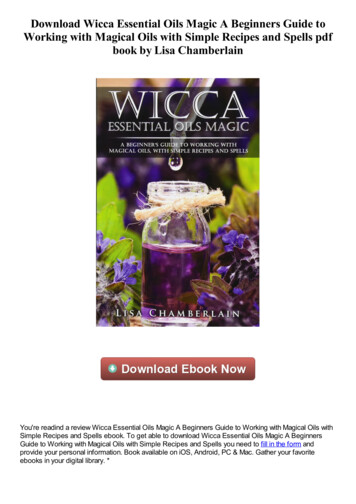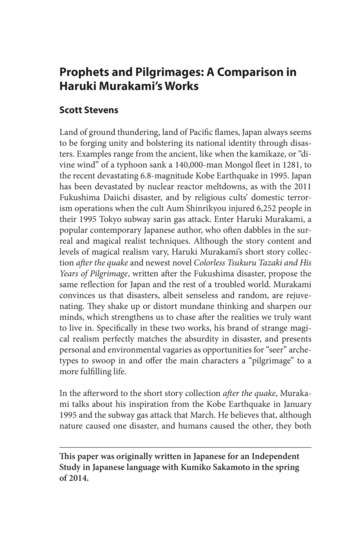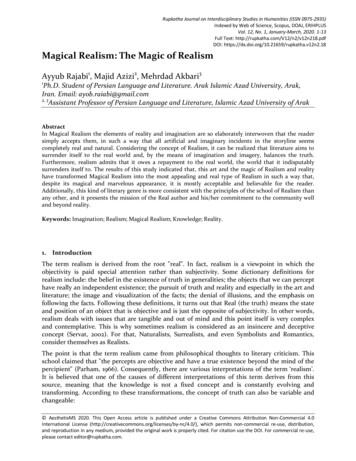
Transcription
Rupkatha Journal on Interdisciplinary Studies in Humanities (ISSN 0975-2935)Indexed by Web of Science, Scopus, DOAJ, ERIHPLUSVol. 12, No. 1, January-March, 2020. 1-13Full Text: http://rupkatha.com/V12/n2/v12n218.pdfDOI: al Realism: The Magic of RealismAyyub Rajabi1, Majid Azizi2, Mehrdad Akbari31Ph.D. Student of Persian Language and Literature. Arak Islamic Azad University, Arak,Iran. Email: ayob.raiabi@gmail.com2, 3Assistant Professor of Persian Language and Literature, Islamic Azad University of ArakAbstractIn Magical Realism the elements of reality and imagination are so elaborately interwoven that the readersimply accepts them, in such a way that all artificial and imaginary incidents in the storyline seemscompletely real and natural. Considering the concept of Realism, it can be realized that literature aims tosurrender itself to the real world and, by the means of imagination and imagery, balances the truth.Furthermore, realism admits that it owes a repayment to the real world, the world that it indisputablysurrenders itself to. The results of this study indicated that, this art and the magic of Realism and realityhave transformed Magical Realism into the most appealing and real type of Realism in such a way that,despite its magical and marvelous appearance, it is mostly acceptable and believable for the reader.Additionally, this kind of literary genre is more consistent with the principles of the school of Realism thanany other, and it presents the mission of the Real author and his/her commitment to the community welland beyond reality.Keywords: Imagination; Realism; Magical Realism; Knowledge; Reality.1. IntroductionThe term realism is derived from the root "real". In fact, realism is a viewpoint in which theobjectivity is paid special attention rather than subjectivity. Some dictionary definitions forrealism include: the belief in the existence of truth in generalities; the objects that we can percepthave really an independent existence; the pursuit of truth and reality and especially in the art andliterature; the image and visualization of the facts; the denial of illusions, and the emphasis onfollowing the facts. Following these definitions, it turns out that Real (the truth) means the stateand position of an object that is objective and is just the opposite of subjectivity. In other words,realism deals with issues that are tangible and out of mind and this point itself is very complexand contemplative. This is why sometimes realism is considered as an insincere and deceptiveconcept (Servat, 2002). For that, Naturalists, Surrealists, and even Symbolists and Romantics,consider themselves as Realists.The point is that the term realism came from philosophical thoughts to literary criticism. Thisschool claimed that "the percepts are objective and have a true existence beyond the mind of thepercipient" (Parham, 1966). Consequently, there are various interpretations of the term ‘realism’.It is believed that one of the causes of different interpretations of this term derives from thissource, meaning that the knowledge is not a fixed concept and is constantly evolving andtransforming. According to these transformations, the concept of truth can also be variable andchangeable: AesthetixMS 2020. This Open Access article is published under a Creative Commons Attribution Non-Commercial 4.0International License (http://creativecommons.org/licenses/by-nc/4.0/), which permits non-commercial re-use, distribution,and reproduction in any medium, provided the original work is properly cited. For citation use the DOI. For commercial re-use,please contact editor@rupkatha.com.
2Rupkatha Journal, Vol. 12, No. 2, 2020“ the interaction between reality and imagination is the basis of the identity of literature.Wallace Stevens repeatedly addresses it in the subtle movements of that eternal equation.He believes that reality is not what it is. It is a combination of many facts that can bedivided into them. No truth is a mere truth, and no one is universal in itself; the interplaybetween things makes them fruitful" (Grant, 2016).Philosophical literature and sociology also considered the truth as a criterion for knowledge. Theydo not recognize the concept of truth as permanent and eternal, rather as the adaptation to thereality system of true existence. In other words, it can be said that the subject of knowledge is, infact, human being plus the existence that both are changing and challenging. For this reason, thesubject of knowledge (human) and the theme of knowledge (environment) are both changing andtransforming. Inevitably, the relation between them which is knowledge cannot be fixed, too. As aresult, the truth that is the trait of knowledge cannot be a fixed and definite quality. As theeternal existence is in the process of transformation, the truths also change. Therefore, it can beconcluded that the truth is both broad and changeable due to social conditions and time. On theother hand, considering it as a simple case can also lead to anti reality. In literature, the objectiveimage of life is not realism, because the image of something that is observable through eyes onlyreflects the external aspect of the phenomena and, ultimately, transforms into a soullessphotography:“The goal of Realism is to search and express the real qualities of everything and theinternal relations between a phenomenon and other phenomena. Realist literature doesnot study natural and social creatures as the single and self-consistent creatures, but treatsthem as endless chains of action and reaction” (Seyyed Hosseini, 2002).As a result, from the perspective of literature, sometimes Romanticism is also realism. Thisgeneral belief that in literature, Romanticism is anti-realism, is not readily acceptable, because insome situations, like the circumstances prevailing the Romantic era in the West, the romanticconcept can also go beyond the apparent reality. In this regard, Dostoyevsky says“A romantic person is one who has realized the falseness of the values of the eighteenthcentury. Values that in that century were against traditional classical values. The missionof his century was to deal with the new-structured religious and social faith with Byronand Lermontov kind of individual grief’ (Parham, 1966).Therefore, realism and romanticism are not two opposite schools, because romanticism throughexploring the tangible world was the beginning of realism and instead of exact exploring andsearching, replaced the analysis with integrated inspiration, and tended to explain the details.Nevertheless, it should not be concluded from this argument that there are no definiteboundaries between literary schools, because, despite the problems of defining and specifying thescope of each school, it is possible to distinguish them from their dominant features.So far as realism is concerned, we find that literature aims to surrender itself to the real worldand, by the means of imagination and imagery, balances the truth.“Realism, as the conscience of literature, admits that it owes a repayment to the realworld; the world that it indisputably surrenders itself to it. So, realism is an artisticformula that with a certain understanding of reality tries to depict it” (Parham, 1966).In this study, we consider magical realism, which is one of the branches of realism, againstrealism itself. By examining them, we seek to find the true connection between the schools ofrealism and magical realism. Indeed, the main purpose of this study is to find out if the nature of
3 Magical Realism: The Magic of Realismmagical realism is the result of the magic of realism? That is, if the style of realism has created amagical realism by the means of a series of special features?Based on the argument above, the following questions are put forth.2. Research Questions1.2.3.4.5.Does the magical state of realism increase or decrease its value?Why do not the writer and characters of the story have any doubts about the reality ofthe story and its events?Why does the writer of such works insist on the reality of characters and its incredibleincidents?Regarding the nature of the school of realism, which seeks to depict the ugliness of thesociety to reduce its suffering, does magical realism also have such a function?How does the acceptance or rejection of magical realism affect the process of the storyand its characters?3. Hypotheses1.2.The art and magic of the school of realism in its most complete and mature form,forms magical realism.Magical realism and its beliefs are vital for the characters of the story.4. BackgroundThe term magical realism was first used in 1925 by the German critic Franz Roh to describe agroup of post-expressionist painters. But the use of this term as a literary school traces back to1949, when the Cuban writer Alejo Carpentier used it for the first time in the introduction of hisbook The Kingdom of this World. However, some believe that the history of this school dates backto the works of Kafka (Trial) and Bulgakov (Master and Margarita) between 1928 and 1938, but itsreal beginning and peak is related to the authors of Latin America. Writers such as Carlos Fuentesfrom Mexico, Jose Maria Arguedas from Peru, Miguel Angel Asturias Rosales from Guatemala, andmost famously Gabriel Garcia Marquez from Colombia, are the followers of this school. In Iranthe signs of magical realism can also be found in the works of Gholam Hossein Sa'edi, MahmoudDowlatabadi, Monir Ravanipour, Yousef Alikhani, and Reza Barahani.4.1 Magical RealismSince the 1980s, terms such as "magic realism", "magical realism" and "marvelous realism" havebecome so common and at the same time ridiculous terms. These terms are apparently composedof contradictory words. A form that shows the relationship created between these mutuallyexclusive terms is compulsory and obligatory. In recent years, of the three terms mentionedabove, "magical realism" has become the most common term. What a narrative method offers, infact, is a way of exploring different types of reality-based approaches in Western philosophy,embodied in many post-colonial and non-Western fictional works like the works of famouswriters such as Gabriel Garcia Marquez. So far, no writing style has been so popular amongordinary readers, but what concern the critics and writers is that this term has diminished to an“obscure cliche” (Ann Bowers, 2014).
4Rupkatha Journal, Vol. 12, No. 2, 2020The school Magical realism can be defined in two ways: 1) It can be considered merely a techniquein telling the story, and 2) a method for narrating a story based on a particular attitude towardsreality. According to the above-mentioned definitions, this school is not merely a technique, butrather a kind of belief in reality, a reality that is more complex and mysterious than what appearsin the first place. In fact, this school is a mixture of reality with legendary elements and dreamlikeand imaginative events, as well as myths or folklore. Based on this definition, in this school,unrealistic events occur in the context of a story that seems real, but these events may only seemstrange, unrealistic or abstain from the reader's point of view. For the author and the storycharacters, these events are not beyond the scope of probabilities. This marks the boundarybetween magical realism and other storytelling styles. In the review of the history of thestorytelling, we find that the events that seem real and the events that originate from the mindand are improbable have different definitions such as myth, fables, romance, social realismstories, science fiction, and fantasy stories. In magic realism, there is no boundary betweenimagination and reality, and real elements combine with fictional elements and become realistic.The elements of fiction appear in most stories, but the mere existence of fictional elements in thestory does not allow the story to be considered as magical realism. Magical realism, creates thepossibility of occurrence of an unrealistic phenomenon in the context of reality which “does notfully belong to the realm of imagination and not to the realm of reality and experience, but it hasan independent feature.” Mirsadeqi, 1998)The emergence and overgrowth of this school in Latin America is related to the sovereignty ofsuffocation and the long repression of colonial governments and domestic self-dictatorships, thestudies of western anthropologists about the Indian culture and myths, the great desire of thispeople to narrate the historical events and the pressure of all these events on the nation and thewriters that ultimately were not allowed to express the reality freely. All these factors led to thedevelopment of a particular kind of realism (Dad, 2006). Therefore, this kind of expression can beconsidered as a special way of the school of realism, which the Latin American authors havechosen to do in conscious literary activity in order to awaken public thought.Of course, this school is considered to be a special school specific to the Third World. Also, it isan exploration of the distant relationship between the primitive minds of these nations that arecompletely alien to Western culture. This school is involved with the native myths that aremanifested in the realities of Latin American life. It has created its own world; while being specificto each nation, its joint effects may also appear in the future.5. The Components of Magical RealismIn the magical realism style, the elements of imagination and reality are so combined, ultimatelycreating a kind of story that does not resemble any of its original elements. This combination is soelaborately performed that all of the fantastic imaginary events in the storyline seem real andnatural, and the reader easily accepts them. Thus, magical realism is a combination of the twoelements of imagination and reality, in such a way that it is difficult to distinguish and isolatethem.The components of magical realism in all the stories of this style are not the same, because in onestory some elements may have more effect, and in others they may be less or non-present at all.The components that appear in most magical realism stories are as follows:
5 Magical Realism: The Magic of Realism5.1 AmbiguousnessIn the narrative structure of such stories, the story elements are in a state of ambiguity, and theauthor makes a vague image in order to integrate the real and the supernatural world. Forexample, the vagueness of the names of individuals or time and place are in a mysterious state. Infact, this dichotomy is one of the most important features of the magical realism stories. "Authorswho write in this style include heterogeneous scenes in the form of contrasting scenes such asrural and urban, western and native, real and imaginative, natural and supernatural asintertwined elements "(Mirsadeqi, 1998). For example, in the story of Azadaran-e Bayal, Bayal isthe name of a region in which people’s dilemmas are manifested in illusory and imaginativespaces. In fact, Bayal is a symbol of the world that Sa’edi portrayed in a shadow of ambiguity.5.2 CharacterizationIn the magical realism stories, we see that the writer uses characterization in order to show itsstory real, and through objectifying some factors, tries to achieve this goal. In fact, to makeimaginative elements seem real is the basis of magical realism stories. The characters of suchstories are representative of the archetypes of the same land that show the collective unconsciousin the sequence of the story with different titles. In the character analysis of such stories, mostcharacters are dual, sometimes moving from the real world to the imaginary world or vice versa,without amazing themselves or the audience. In fact, "this dual characterization enables thewriter to impose strange and imaginary events on the subject of the story in order to add to itsimaginative state" (Nikoubakht; Ramin Nia, 2005).5.3 Making TangibleIn magical realism, events occur as if they are in the real world. For this reason, the acceptance ofcharacters and events is very common to the audience. In fact, in these stories phenomena are notimaginative and subjective, but they are concrete and objective, and the balanced coexistencebetween reality and magic is completely felt. In this style, the writer tries to describe unusual andstrange events with a reality-based statement and avoid a threatening tone. He never tries toinvestigate or explain the reason for incredible events. Events and characters live in both real andsupernatural world, and they do not get excited when moving from this world to the other. This iswhy in the works written in this style, on the one hand, there can be no distinct boundarybetween the real and the supernatural world, and on the other, the incidents seem believable andnatural.5.4 Symbol and MythAnother component of the magical realism is the bold effect of national and local myths. In fact,the myth revolves around some extraordinary events and supernatural deities, and from thesesymbols and myths, people create creatures beyond the scope of ordinary imagination and reason.As a result, the symbolism that often occurs in these stories can also be the cryptic representationof thoughts and indirect criticisms of the political, economic, and social atmosphere governingthe writer's community. For example, "cow" is the symbol of fertility in mythology, and in a villageit is a medium between the earth and man. This myth has long been the symbol of fertility. "Thismyth is so strong that in the Avesta’s Gathas, some of the clauses begins with the swear tocow"(Al-e- Ahmed, 1965). A mouse is also the symbol of destruction. For example, in theAzadaran-e Bayal, a mouse is depicted as destruction
6Rupkatha Journal, Vol. 12, No. 2, 2020“the Bayal, its roads and farms is filled with mice. Wherever you go a mouse takes his headout of the hole and watches you. How big they are, they are rude and nosy and poke theirnose everywhere they are” (Saedi, 2012).5.5 MetamorphosisOne of the aspects of the magic is "metamorphosis". Regarding the magical realism, whenaperson's identity changes from a higher position to a lower one, this event seems to be verycommon to the reader or observer. The reason is that, in the ancient myths and stories, suchevents have always existed and the audience encounters these events with previous background.For example, in the Qur'an and other religious books, the story of the miracles of the prophets ismentioned. This makes the audience easily accept the concepts of magic. In the story ofAzadaran-e Bayal, when "Mash Hassan" loses his cow because of a severe grief, he suffers from aninner transmutation, so that he considers himself a cow: "As he was chewing he said: I am notMash Hassan, I am a cow, I am Mashadi Hassan’s cow" (Saedi, 1391, 106).6. Magical Realism and the Magic of RealismIn the definition of magical realism, we referred to two categories of imaginary and real elements.These two categories are easily recognizable for all human beings. In fact, the distinction betweenimagination and reality should be viewed from two different perspectives: 1) the audience, whichis in the form of a reader in these stories, and 2) in film and painting as a viewer), from theperspective of the writer (creator) or the characters of the story. If we look at the subject from theviewpoint of the reader, we understand that what may be imaginary in a culture or a historicalperiod may appear quite natural and real in other cultures and other periods. From theperspective of audience, these two categories of imaginary and real elements are definitelymutually exclusive, otherwise magical realism has no longer any meaning. If we look at thissubject from the perspective of the writer or the characters of the story, it is understood thatelements such as magic, angel, dream, soul, etc., which the audience consider unrealistic, are notcreated by the mind of the writer, but rather, besides being a part of the world of the story’scharacters, is also a part of the real world. In fact, the audience may have doubts about the realityof the elements of the story, or consider them as real, but the writer (creator) and his charactershave no doubt about the real nature of these elements. In magical realism, the writer shows thereality by illustrating and describing the elements in the story and the magical and supernaturalbehavior of the characters which is apparently the real.The writer does not analyze the characters of the story rather, by intertwining daily, historical,popular beliefs and times, creates a multidimensional picture of reality. Interestingly, theaudience is not surprised by the unusual events that occur during the story. On the one hand, theauthor expresses reality, and on the other, by putting together imaginary and real elements,attempts to induce the elements as real to the reader. He does not express the truth or falsity ofthe events, and this makes the audience feel the author, and the characters of the story believe intheir statements.In this part, the questions raised for this study are explored. First, we will discuss the syntax of thetwo terms "magical realism" and "magic of realism". The term "magical realism" is a combinationof the noun plus adjective that represents realism in a supernatural way, while the term "magic ofrealism" is a combination of a possessor and a possessive and expresses the properties andfunction of realism. Therefore, these two terms represent two separate concepts and thus it isincorrect to use them interchangeably. "Realism means the explicit and complete expression of
7 Magical Realism: The Magic of Realismindividualities, so, the contract, imitation, and any kind of school, is the target of realism" (Grant,1996). As we know, the perspective of realism, changes in the stages of meta-realism orsurrealism. According to the followers of this style, unconscious contents, everything that passesthrough the minds of a person (if it is written before thinking), words that come outspontaneously, and the dream are all parts of the basis of surrealism. In surreal methods,abnormal properties attributed to common objects, or objects and concepts that are apparentlyunrelated are put together. Surrealists consider real human activity as the dreamlike activity ofthe inner voice of the unconscious world. They believe that many human thoughts andimaginations are not expressed because of being bound to ethics and society or politics, andinevitably, these imaginations are driven deep into the unconscious mind. Such thoughts anddesires often appear in dream, jokes and the words that unconsciously slip out of mouth. Thesurrealist style agrees with the clear and honest expression of such thoughts, imaginations anddesires. One of the confusions in understanding the magical realism lies in its coincidence withsurrealism, because there are similarities between these two movements. The surrealists aimed todepict the hidden mental aspects of life in art. After the war, they sought new things and tried to“harmonize contradictions and conflicts” (Ann Bowers, 2014).“The surrealist writer is not inspired, but inspires. His image does not represent anysubjectivity or sensibility. It creates the mindset and stimulates sensitivity. The oppositionof the contradictory concepts and words is to break the deductive aspect of the mind andto save the imagination"(Bigsby, 2016).To answer whether the magic of realism increases or decreases its value, firstly, it is imperative toreview the value of the realism school. As we know, the value and position of the realism schoolamong other schools is that it emphasizes reality, and this is the distinguishing point of this style.But, what is real and what is unreal in this style is debatable. Looking at the form of magicalrealism, it becomes clear that it contrasts with realism, because the motto of realism is reality andthe motto of magical realism is magic in the cover of reality. However, in the epistemology andontology that we will refer to shortly, we observe that realities vary in terms of individuals andsituations. Thus, this relativity of reality makes us consider the imaginations of magical realismreal in which the author himself also believes to be real, and has no argument over on whetherthey are imaginary. As a result, magical realism not only does not diminish the value of the styleof realism, but also illustrates the power of realism, that how it depicts unrealistic events realisticso that the audience does not hesitate about it. Realism with magic in the first place can bespectacular and interesting, an exquisite question the exploration of which exploring it bringsnew and vivid image of reality, a reality that is more prominent than any truth, and conceals dueto the severity of disclosure.Magical realism is not a style or a literary school which has special authors who write along thelines of its framework, rather it is a part of realism and reality, based on the disadvantageouscircumstances of life of which, man gets help from it. Hence, such works are not considered asmagical or real. Therefore, it does not matter what that magic of thought is, and even how far it isfrom the wisdom and logic for other human beings. This is the influence of this belief andthought on people’s life which is significant and causes them to endure suffering. The samethoughts that have become a part of the reality of life can be seen in folk superstitions and beliefs;for example, the omen of a sneeze before beginning a work or the evil eye that has had a greatimpact on public belief in life.We need to discuss beliefs in order to figure out why the author and characters of the story do nothave any doubts about the reality of the story. Most people in every field of social and
8Rupkatha Journal, Vol. 12, No. 2, 2020occupational work try to apply their beliefs in life. The writers of such stories also emphasize ontheir beliefs because they believe them, and these beliefs are derived from the inside and theheart. The writer is not trying to create a magical realism story but expresses the real story whichcritics consider as magical realism. But from the writer’s point of view, a real story is based on thereal events, and because these stories are not artificial and arise from the writer's belief, theaudience also inevitably accepts them as real and reads them without any doubt.Moreover, writers who have some works in this literary style speak about their own living place ortravel to such places. However, if such works were the result of the writer’s mind, then therewould be no need to travel and observe and emphasize on the reality of these works. The writersalso did not need to deny something called magical realism.The characters of magical realism are so artistic that they live in the realm of such amount ofdisappointment and have become so aware that as a descended angel try to return to heaven. Animportant point here proving that such works are realist is that the art of the characters ofmagical realism in reality is much higher than the writer's art, to the extent that they amaze thewriter, the writer who finds writing about the lives of such people more interesting than creatingsuch characters. So, instead of creating a character, s/he discovers them.Regarding the nature of realism as a school, which seeks to depict the ugliness of the society toreduce its suffering, we need to know if magical realism also has such a function. It should be saidthat magical realism writers, like realists, are not just paying attention to good things, but try toportray the ugly issues of society as well. As a precise sociologist, they explore the underlyingfacets of social reality and reveal the moral corruption, types of exploitation, poverty, hunger, andinhuman relationships. The writers of these stories explore the bad and ugly aspect of society.They write about poverty, hunger, misery, depravity, lies, brutality, insult, violence, cruelty andoppression toward common people, and depict a true and realistic image of the community.Accordingly, the common suffering of these people which drives from their collective mindsundoubtedly is immediately acceptable. Therefore, no matter how amazing these stories are, thefocus here is not on their disbelief, but it tells of their great suffering which demands profoundthought. The reality begins from the description of what we observe but it does not remain andends with it. The real truth is the mind and thoughts that make the life possible for human in allcircumstances and take it forward. On the other hand, it should be considered that how to aperson, this amount of poverty, death, famine and ruin is believable and tolerable. The humanbody will not tolerate this amount of pressure and collapse but what prevents it is his mind andthought, which are as much real as much his body. So, both the body and the mind try to surviveand what the mind decides, the body accepts immediately to save itself. The magic of reality islike this too. If it does not believe such charming and captivating magic, the body would nottolerate this much pressure. Therefore, the magic of mind and thought make a reality thatensures the life of human beings with this amount of problems. The amazing magic is that themore poverty and misery it contains, the more real it is. From this perspective, such a magic turnsout to be more realistic than any truth. The magic that the life and death of a nation depends onand the slightest doubt they have about its nature can lead to the destruction of these people. Inother words, the more suffering and difficulties in a land, the more real the magic of realismseems. Sa'edi, in his book Ahl-e Hava, argues that Ahl-e Hava refers to anyone who is stuck in oneof the winds, and the winds means all the mysterious, ethereal forces that are everywhere anddominat
The results of this study indicated that, this art and the magic of Realism and reality have transformed Magical Realism into the most appealing and real type of Realism in such a way that, despite its magical and marvelous appearance, it is mostly acceptable and believable for the reader.


